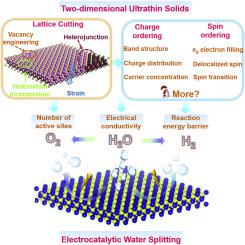Chem ( IF 19.1 ) Pub Date : 2018-03-22 , DOI: 10.1016/j.chempr.2018.02.006 Youwen Liu , Chong Xiao , Pengcheng Huang , Ming Cheng , Yi Xie

|
Electrocatalytic water splitting, which underpins a series of sustainable energy conversion technologies, has become even more relevant as our energy needs have increased. Exploring efficient non-precious-metal electrocatalysts is necessary for the widespread application of this energy storage model. Two-dimensional (2D) ultrathin solids with a special atomic and electronic structure are full of unlimited potential in the pursuit of high-efficiency electrocatalysts and have been identified as a perfect platform for establishing clear structure-property relationships. Hence, in this review, we first clear up the fundamental relationship between intrinsic charge and spin ordering and electrocatalytic properties. Then, on this basis, we summarize recent attempts to regulate electrical behavior and spin ordering in 2D ultrathin solids to optimize electrocatalytic water-splitting performance. In addition, we highlight the coupling relationship among lattice, charge, and spin ordering in ultrathin electrocatalysts. Finally, we also present some personal perspectives on the challenges and future research directions in this promising area.
中文翻译:

调节二维超薄固体在电催化水分解中的电荷和自旋有序
随着我们对能源需求的增加,支持一系列可持续能源转换技术的电催化水分解技术变得越来越重要。对于这种储能模型的广泛应用,必须探索有效的非贵金属电催化剂。具有特殊原子和电子结构的二维(2D)超薄固体在追求高效电催化剂方面具有无限的潜力,已被认为是建立清晰的结构-性质关系的理想平台。因此,在这篇综述中,我们首先弄清了固有电荷与自旋有序性和电催化性能之间的基本关系。然后,在此基础上,我们总结了最近在2D超薄固体中调节电行为和自旋有序以优化电催化水分解性能的尝试。此外,我们重点介绍了超薄电催化剂中晶格,电荷和自旋有序之间的耦合关系。最后,我们还提出了一些个人观点,介绍了这一有前途的领域中的挑战和未来的研究方向。











































 京公网安备 11010802027423号
京公网安备 11010802027423号